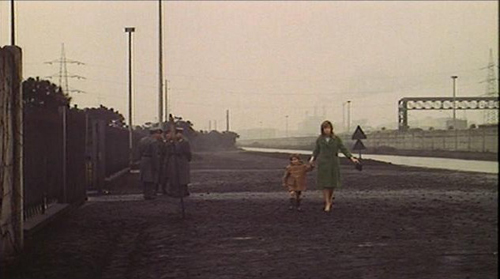Michelangelo Antonioni’s Red Desert, which begins a ten day run at BAMcinématek this afternoon, is surely one of the most beautiful ugly movies ever made. The colors are largely gray and murky, and the apparent progress of red radar masts transform communication into something which looks more closer to derricks. Water isn’t just dark and polluted; it is oily and smoky, very much living up to its Lethean role. Sickly yellow enters near the end with a resigned acceptance. Rooms, painted with bright red, are cold and subject to random destruction. State-of-the-art robot toys crash around dark rooms over and over and over. Spoiled children don’t feel any special desire to get out of bed. They even willfully fool their mothers into believing that they have a serious illness. Large areas are filled up with endless bric-a-brac, with one wondering how it all got there in the first place.
Given all this bleak imagery and given the seemingly slim story (Giuliana, a young mother married to an engineer, is suffering mental breakdown), why then would anyone want to see Red Desert? Why then would anyone be so drawn to Monica Vitti’s miserable face, which seems equally tortured by environment and filmmaker and often dons a very sad smile for protection? Largely because of Antonioni’s audacity and largely because everything here is not as it seems. This was his first film in color and he was determined to paint nearly every building around him. Pipes, walls, the insides of a vacant cottage? Chances are that it was painted. Chances are that the actors were positioned not to show off their talent, but for Antonioni to show off his brush strokes. And it all makes Jean-Pierre Jeunet’s modifications of Paris by CGI look outright lazy by comparison. It’s hard to imagine anyone going to such trouble today, and I wish that they would. Red Desert reminds us of those halcyon days when filmmakers strewed their streets with serious trash and rolled up their sleeves to accentuate abject locales.
The other reason to see Red Desert is largely as a test in mood. Because Red Desert may be a depressing film, if you can still find something cheery about the world afterward, you may very well be an optimist. But in your quest to find beauty within the abject, does your soul become abject? Like anything in life, it’s all a matter of perspective.
The above sequence is about as alienating as art house cinema gets. Giuliana wishes to escape her increasingly populated environment. But instead of offering help or providing some fun aside from eating eggs (augmenting your fertility: is this really what frivolity is all about in the Antonioni universe?) or wanton destruction (red wooden walls destroyed, along with a chair), her friends can only stare into the world around them. They are statuary dissipating into the fog. Should Giuliana be blamed for this? Is this merely the way that she looks at the world? She decides to act by nearly driving a car into the watery abyss (an attempt at suicide or a response to this miasma?). She says, “Forgive me. A mistake.” She claims not to have seen the ship. All she wanted was to drive home. But what is home? And is what we are seeing here a mistake?
A 1965 review published in Life suggested that Antonioni was “getting to the point where he has nothing new to say about nothingness.” But this assumes that experiencing Red Desert is merely accepting “nothingness” without considering that it may be something else or that mood or style can suggest other emotions. Antonioni is all about confronting our perceptions about the way people live with colors. Giuliana commits an act (or does she?) near the end of the film — just before saying “Why do I always need other people?” and just before she seems to transform into a piece of human furniture (while clutching a chair, match) and just before tracing her fingers on a map that doesn’t have the place she’s looking for (home?). Much as Jack Nicholson’s David Locke assumes a dead man’s identity in The Passenger to atone for the rebels he can’t seem to locate, Giuliana’s response to malaise is to do something instead of nothing. And it takes observing a dark and slightly bent figure from a window — perhaps some future version of her — to understand that nothingness is a state of mind. What’s especially interesting is that her act causes the room she is in, and all of its objects, to shift into a fleshy pink. So did she actually commit the act? Or did she merely think it? And is thinking a form of doing? Whatever it is (and Antonioni is considerate enough of his audience to leave this open-ended), it does allow Giuliana to return to the world, with great pockets of steam pushing beneath her, and walk away from what seems poisonous without fearing it or worrying about it.
In a year that has given us revolutionary upheaval, natural disasters, and economic uncertainty seemingly without letup, Red Desert is fresher than ever in what it has to say about living.
